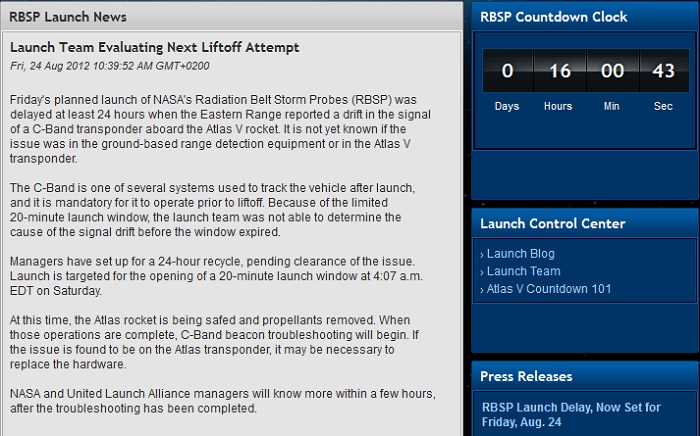-

-
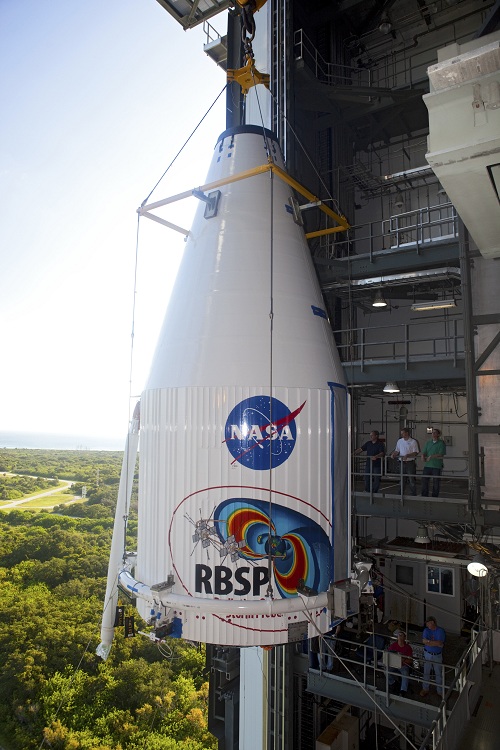
The Atlas V payload fairing containing the RBSP spacecraft is lifted at Space Launch Complex-41, where the booster awaits. Photo credit: NASA/Dimitri Gerondidakis
-
Encircling the Earth's equator are two concentric, wide rings of high-intensity particles known as the Van Allen radiation belts. This dynamic region changes in response to the sun, with the potential to affect GPS satellites, satellite television and more.
NASA's Radiation Belt Storm Probes (RBSP) mission aims to study this ever-changing environment in greater detail than ever before.
"We live in the atmosphere of the sun. So when the sun sneezes, the Earth catches a cold," explained Nicky Fox, deputy project scientist at Johns Hopkins University Applied Physics Laboratory (APL) in Laurel, Md. "So whatever is happening on the sun, the Earth will feel an effect and will respond to that changing space weather."
The mission features nearly identical twin probes, each carrying a suite of advanced instruments to help scientists monitor and characterize changes within the radiation belts.
"The Radiation Belt Storm Probes will give us a better understanding of how the radiation belts actually work, and allow us to do a better job of predicting and protecting against the radiation that's up there in the future," said Mission Systems Engineer Jim Stratton, also of APL.
The RBSP mission is part of NASA's Living with a Star program, which is managed by the agency's Goddard Space Flight Center in Greenbelt, Md. The APL team built the RBSP spacecraft and will manage the two-year mission for NASA.
The discovery of the radiation belts dates back to the dawn of the space age. Their existence was detected in 1958 by a Geiger counter on NASA's first spacecraft, Explorer 1, built by James Van Allen and his team from the University of Iowa.
Now, more than half a century later, RBSP packs a comprehensive set of instruments designed to look at not only the particles within the radiation belts, but also the plasma waves, electric fields and magnetic fields that transport and guide those particles.
The mission needed two probes, Fox explained, because scientists want to be able to distinguish transient features from those that are there for a longer period, or may be changing.
"If you imagine having two buoys in the ocean, and one goes up, and comes down again, you don't know anything about what caused that to go up and down," Fox said. "If both of them go up, then you know you've got a very big feature that is affecting both of them at the same time. If you one goes up, then the other goes up, you can measure how fast that wave has traveled between them, and what direction it's going into. And if only one goes up and comes down again, then you've got a very, very localized feature that didn't travel anywhere.
"So in order to be able to really understand what is going on, these very fine-scale features in our radiation belts, we have two spacecraft to do that," she said.
The eight-sided probes weigh more than 1,400 pounds each and measure about six feet wide by three feet high. But the electric and magnetic fields sensors extend outward on booms that distance these instruments from the immediate vicinity of the spacecraft, which could generate its own electric and magnetic fields. Data filters and metal shielding on spacecraft electronics offer additional prevention against interference, as well as protection from the intense environment the probes will encounter daily.
"Definitely the biggest challenge that we face is the radiation environment that the probes are going to be flying through," Stratton said. "Most spacecraft try to avoid the radiation belts -- and we're going to be flying right through the heart of them."
RBSP is launching on the tried-and-true Atlas V built by United Launch Alliance.
"NASA has an excellent history with the Atlas V rocket. As a matter of fact, we are 100 percent, six for six, launching on Atlas V," said Tim Dunn, RBSP launch director for NASA's Launch Services Program (LSP). "We have launched missions to Jupiter, Pluto, the sun, the moon, and two missions to Mars."
Based at NASA's Kennedy Space Center in Florida, LSP has been involved in prelaunch planning for the RBSP mission for several years.
"The team has been preparing in total for about six years for the RBSP mission. The early planning began that long ago, back in about the 2006 timeframe. The core team came in at about contract award time in March of 2009," Dunn said. "So we've been very heavily involved with RBSP for the last three years."
Rex Engelhardt, LSP's mission manager for RBSP, has been working on the project since 2006. He pointed out that ensuring the separation of both spacecraft from the Centaur upper stage, after launch, required some extra attention. The probes will be deployed one at a time into separate orbits, so the Centaur will spin up, deploy the first probe, stop its spin, and then turn to aim the second probe toward its orbit.
"Then you've got to point it in the right direction, spin it back up again, separate the second (probe), then you've got to spin the Centaur back down again, and quietly back away," Engelhardt said.
Once the probes are placed in their proper orbits, they'll undergo a two-month "commissioning period." This offers the team plenty of time to extend the instrumentation booms, check out the probes' health and safety, and ensure the electronics are working.
"After you launch, after you get through the environments of launch and when you're up there in the space environment, you want to make sure everything's working perfectly," Stratton said. "So that takes about 60 days after launch, and then we'll start our prime mission as soon as that commissioning period is done."
According to Fox, the data from the RBSP mission will allow scientists dramatically improve current models of how the radiation belts form and change in response to the sun.
"That is important because it will allow us to design better spacecraft; we'll be able to protect them better and we also won't do costly overdesign," Fox explained. "It will help us protect astronauts that are out in Earth orbit, and it will benefit the science community by giving us a lot more information about fundamental particle physics.
Quelle+Fotos: NASA
-
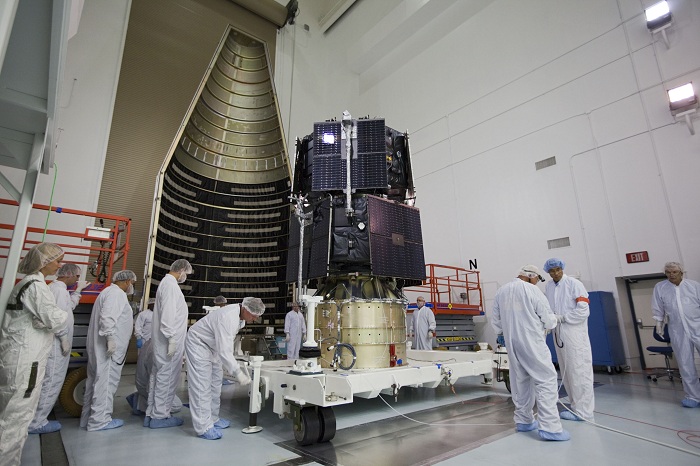
Technicians at the Astrotech payload processing facility prepare the RBSP spacecraft for encapsulation in the payload fairing. Photo credit: NASA/Kim Shiflett
-
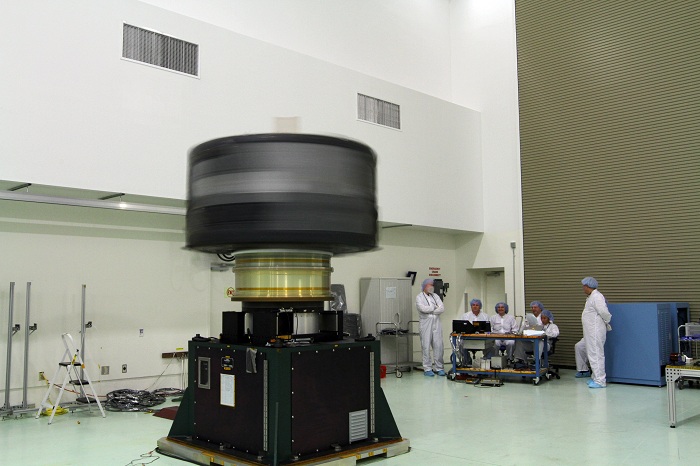
Spacecraft A, one of two Radiation Belt Storm Probes, is checked for proper balance during a spin test. Photo credit: NASA/Charisse Nahser
Quelle+Fotos:NASA
-----------------------------------------------------------------------------------------------------------------------------------------------------------
Update: 24.08.2012
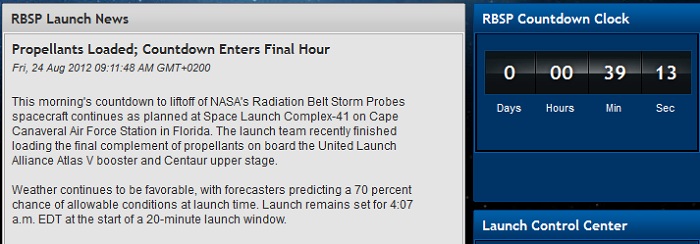
Frams: LIVE-Aufnahmen von NASA-TV

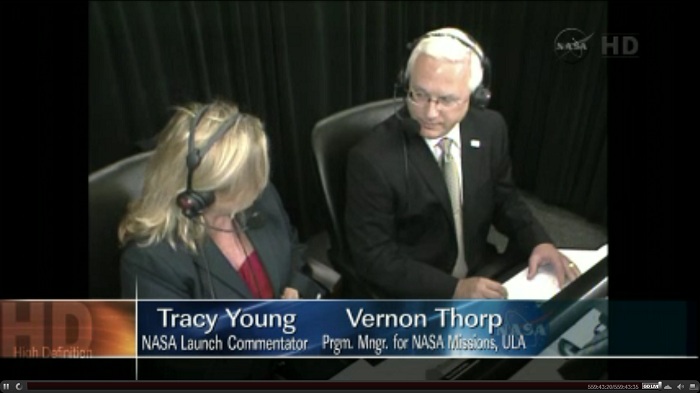
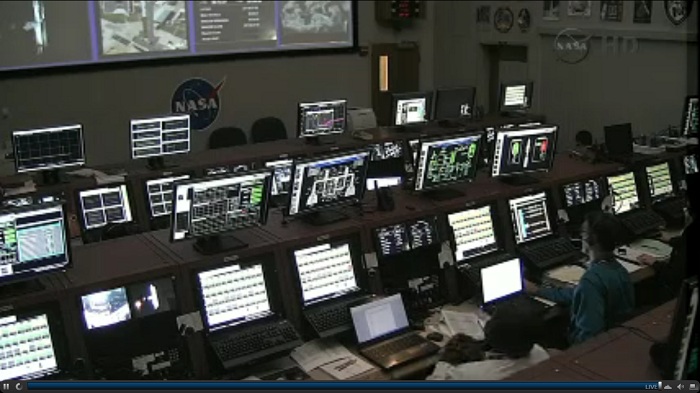

Start um 24 Stunden verschoben...
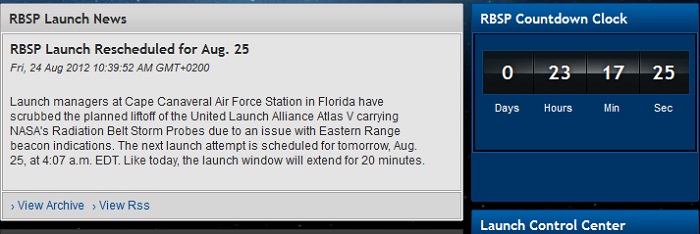
--------------------------------------------------------------------------------------------------------------------------------------------
Update: 24.08.2012 / 18.00 MESZ
